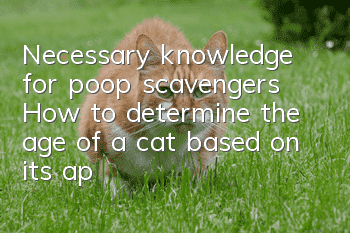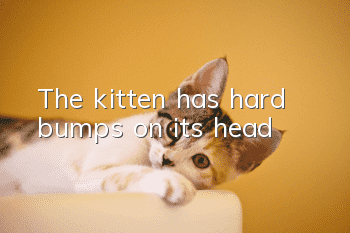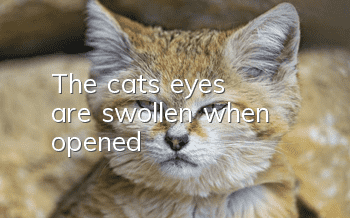Necessary knowledge for poop scavengers: How to determine the age of a cat based on its appearance?

When we started to raise cats, we inherited them from others, or they were stray cats picked up on the roadside. Of course, they may also be adopted cats from some institutions. So when it comes to raising cats, there are different ages. There are different feeding methods, so we must first determine how old the cat is before we can feed it in a targeted manner based on the cat’s nutrition. How to judge the age of a cat based on its appearance? Next, let’s follow the editor to find out.
How to determine the age of a cat based on its appearance?
Teeth, eyes, gums and fur can all reflect a cat’s age.
Of course a cat's lifestyle and care and environment will also have an impact on these appearances, for example if it was a former stray or was neglected by a previous owner, as well as any underlying health issues, all These can have an impact on your cat’s appearance and overall health.
A dental exam is the best way to determine your cat's age, but it's not 100% accurate. If a cat has been receiving good dental care (such as regular brushing), then its teeth will definitely be better than a cat who only eats canned food without dental care.
Teeth Cat’s teeth are divided into three categories like humans: incisors, canines, and molars.
Cats have 26 deciduous teeth, which are replaced by 30 permanent teeth after 6 months. Before 4 months, the teeth are deciduous. There may be slight bleeding when the teeth are replaced. The deciduous teeth are generally not found because they will be swallowed by cats. The deciduous teeth may not fall out, but if they have not fallen out after 8 months, you need to go to the hospital to have them extracted, otherwise it will affect the growth of permanent teeth.
Kittens are born without teeth. Their teeth will change as they age:
2 weeks: The deciduous incisors (the small teeth at the front) begin to grow.
3-4 weeks: Baby teeth (the long canines near the front teeth) begin to grow.
4-6 weeks: The deciduous premolars (also called bicuspids, the teeth between the canines and molars) begin to grow.
8 weeks: All baby teeth have erupted.
At about 3-4 months, the incisors erupt, followed by the canines, premolars, and molars at about 4-6 months. All permanent teeth should be fully grown by 7 months of age.
1 year old: Teeth are white and tartar-free.
By the age of 2, tartar begins to accumulate on the teeth and the teeth begin to turn yellow.
3-6 years and above, tartar accumulation is widespread, yellowing increases, and back teeth show signs of wear. Look for signs of gingivitis or gum disease. These include bad breath and redness of the gums where the teeth meet.
6-10 years. The teeth have been worn a lot and there may be some pigmentation on the gums.
More than 10 years. The teeth are severely worn and some teeth may be missing at this age.
Good dental care, such as brushing your cat’s teeth frequently and going to the pet hospital regularly to clean and remove tartar, is very important to maintain the health of your cat’s oral cavity and teeth. Body Size Most (but not all) cats reach their basic size by 12 months of age (approximately 15 years of age in humans). Some larger breeds, such as Maine Coon cats, can continue to grow up to 4 years old, but they are only a minority.
At 1 year old, their fur is still soft and has a youthful appearance (like that of most 15-year-olds). Starting from the age of 2-3, they begin to gradually gain weight and become less active and energetic than kittens.
Body color and coat
Young to middle-aged cats should have a tight and lean body, good muscle tone and strength, and a healthy coat that is smooth and shiny.
When they reach about 8-9 years old, they tend to lose some muscle mass and muscle tone. The fur will lose its fullness and condition, become somewhat dull and patchy, and feel rougher to the touch.
Some cats will grow gray and white miscellaneous hair when they reach old age. However, long white miscellaneous hair may not necessarily accurately determine whether a cat is an elderly cat. Some cats may have white miscellaneous hair in their natural coat color.
In addition, middle-aged and elderly cats (over 7/8 years old) are prone to arthritis, which is characterized by stiff gait and reluctance to jump.
Eyes
The kitten’s eyes are crystal clear, clear and bright. The eyes of older cats will become cloudy and lose their luster.
Middle-aged to elderly cats (over 7 years old) are prone to lens opacity, making their eyes appear light blue. This opacity, unlike cataracts, is caused by changes in the refractive index of the lens as we age and does not affect vision.
Cataracts can also cause the eyes to appear blue/grey. They usually appear in elderly cats and cats with diabetes. Cataracts need to be diagnosed and treated as soon as possible after being discovered.
Paws and pads
When a cat reaches middle age and old age, its claws will become dry and fall off more easily, and will grow too long due to lack of claw grinding, and even insert into the flesh pad. Owners should trim the cat's nails regularly.
A kitten’s pads are very soft (like soft leather). Adult cats' pads are firmer (like hard leather), while older cats can become thicker, dry, and even cracked. You can regularly apply some cat foot cream to elderly cats.
Each cat may only accompany you for a short period of more than ten years, but it has exhausted its companionship with you.their whole lives. The aging of cats is a process that we have to go through. In order for cats to enjoy their old age, we should also make preparations in advance and take care of everything for cats.
- How big can a Ragdoll cat grow?
- How soon can a kitten be bathed?
- How to treat genetic diseases in cats? Treatment of genetic diseases in cats!
- What kind of cat food is better for elderly cats?
- What should I do if the cat always goes to the owner’s bed at night?
- What are the symptoms of cat fuss?
- How to take care of a pregnant cat
- Why do cats need to be fed regularly?
- How to bury a pet cat when it dies? Is there any particularity when a pet cat dies?
- Diagnosis and causes of cat obesity



